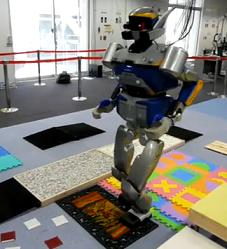
Kawada’s HRP-2 ‘Promet’ robot has conquered its most diabolical nemesis: foam mats. The humanoid bipedal robot recently demonstrated its walking prowess by autonomously traversing a strange obstacle course of foam, rocks, and ramps. Developed in partnership with Japan’s National Institute for Advanced Industrial Science and Technology (AIST) the HRP-2 is slowly gaining attention and accolades, showing that it can perform in the same league as the popular Asimo from Honda or Toyota’s running bipedal robot. Eventually the HRP-2 could be the more widely seen robot. Kawada intends for it to serve as a shared research platform, developing an open API so that other engineering teams can create software to control it. We’ve got a slew of HRP-2 videos for you, some new some old, that highlight its walking skills. Foam mats may not seem like a dangerous enemy to you, but believe me, they’ve conquered their fair share of robots. Watch the HRP-2 avoid a gruesome fate in the first video below.
When robotics companies display their million dollar mechanical babies at trade shows or press conferences it’s always under very controlled conditions. You don’t want a bot taking a tumble and humiliating you in front of a crowd (I’m looking at you here, Asimo). That’s why you always see robots on flat even floors and on clean regular staircases. Even the smallest variations in floor height, especially on surfaces that give or move with added weight, can cause a human-sized bipedal robot to tumble. That’s why HRP-2’s fantastic journey over foam, ramps, and rocks is impressive. It takes some really good software and sensors to compensate for variations in the floor of this kind:
Now of course we’ve seen other walking robots handle unusual terrain. Asimo took on some very interesting dynamic simulated obstacles. The big dog and little dog robots from Boston Dynamics have tackled even crazier real scenarios, but they required four legs to do so. In this context, the HRP-2’s performance is impressive. It doesn’t move terribly fast, and it doesn’t handle a lot of vertical variation (those ramps don’t look any higher than six inches) but it performs nearly flawlessly. The HRP-2 can also handle obstacles on the floor and simple staircases as seen in the following.
Eventually we’ll want humanoid robots to do even better, and to tackle a wider range of situations. If we want a robot in every home (and we do want that, right?) we’ll need them to handle the occasional wet floor, child’s toy, or sliding rug. We’ll also need them to get back up when they do fall down. In that last regard, HRP-2 has already proven itself. Here’s an old video showcasing the robot’s ability to get back on its feet. It looks remarkably human at times.
Some of the lessons learned by the HRP-2 could be helpful with other walking systems. Unfortunately, we’ve yet to see Kawada’s efforts for an open API pay major dividends. JSK and Willow Garage did work with a variation of the HRP-2 that used the open source robotics operating system (ROS), but that wasn’t a walking robot. Likewise, Kawada’s developed miniature robots based on the HRP-2, and these are fairly impressive bots, but they don’t demonstrate any skills we haven’t seen in other small scale bipeds before. Check out the HRP-2m Next and the HRP-2m Choromet in the videos below and judge for yourself.
So while the HRP-2’s walking skills are pretty nice, it looks like it will take awhile for Kawada (and AIST) to put what they’ve learned to good use. Judging by the videos, researchers from around the world have access to the HRP-2 platform, which is a step in the right direction. I would love to see Kawada release more information about its open API efforts, and for more HRP-2 software to be developed on ROS or other open robotics library. Eventually we’ll need all the lessons learned by all the bipedal robots developed around the world in order to create a generation of humanoid bots that can actually move and interact with people in real environments. Such a generation of robots still seems a long way off, but at least we can check off ‘defeat foam mats’ on our To Do list. It’s a small win, but one that deserves some celebration. What do you say, HRP-2, up for a little victory dance?
[screen capture credit: Get Robo]
[source: Kawada]


